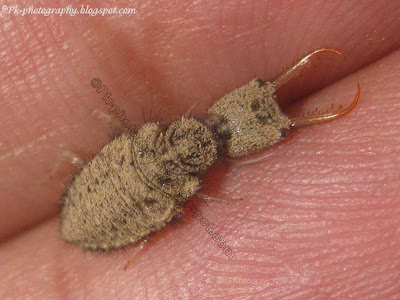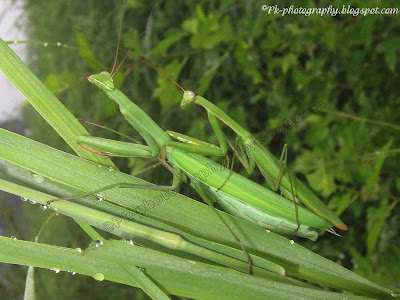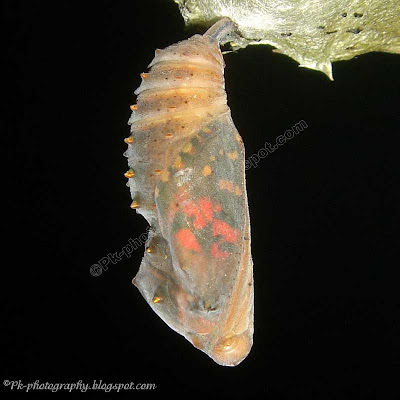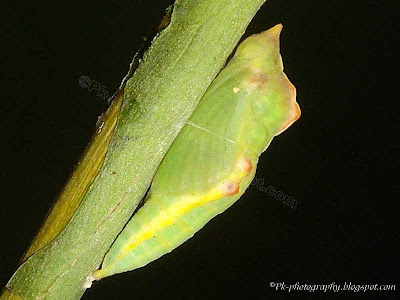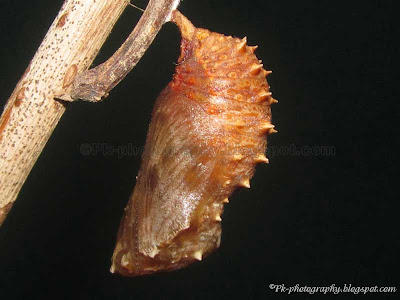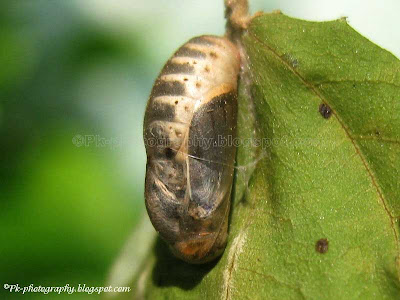A photography blog that focus on Pakistan natural beauty, people, culture heritage, customs and traditions, historical places, travel destinations, wildlife: flora and fauna.
Eudocima materna-Owlet Moth
Eudocima materna is a moth of the Noctuidae family (Owlet Moths), commonly known as Fruit Piercing Moth. They are medium sized moth with a wingspan of about 60 mm. The adult moth has fawn forewings with a variable pattern of pale and dark lines and patches. The hind wings are bright yellow to orange, with a broad dark border having white spots and a dark spot in the middle. The adult is an agricultural pest on citrus and other fruit. It damages the fruit by piercing it with their proboscis in order to suck the juice. The larvae feed on Menispermaceae species, including Roundleaf Vine and Snake Vine.
Fruit Piercing Moth-Eudocima matern
Red Spider Mite
Red spider mite is one of many species of plant-feeding mites belong to family Tetranychidae (spider mites). The spider mites are arachnids, related to spiders. Red spider mite is tiny, crawling, wingless pest that suck the plant's sap from leaf surfaces, causing a heavy damage to plant. They start life with six legs, but develop eight as they grow mature.
Red Spider Mite
Citrus Whitefly-Dialeurodes citri
The Citrus Whitefly (Dialeurodes citri) is a tiny white fly in the family Aleyrodidae. It is a mealy white insect with mealy white wings. Both sexes have two pairs of wings. The wingspan is less than 4 mm.
The citrus whitefly is an economically important pest of citrus. However it also feeds on other species of plants. It attacks the underside of the citrus tree's leaves, sucking sap from it which causes leaves to curl up and turn brown. The adult fly produces honeydew, a sweet by-product of digestion, upon which a sooty fungus grows that damages the fruit and foliage.
The citrus whitefly is an economically important pest of citrus. However it also feeds on other species of plants. It attacks the underside of the citrus tree's leaves, sucking sap from it which causes leaves to curl up and turn brown. The adult fly produces honeydew, a sweet by-product of digestion, upon which a sooty fungus grows that damages the fruit and foliage.
Citrus Whitefly (Dialeurodes citri)
Antlion Larva-Doodlebug
The term Antlion is generally used for both larval and adult form of insects in the family Myrmeleontidae. To differentiate between the larval and adult form we use the terms antlion larva and adult antlion. It got the name antlion because it's voracious predator of ants and other insects. A beautiful name for Antlion Larva is Doodlebug. Antlion larva lives underground and digs a cone shaped pit in the sand to trap ants and other insects. The pit is sloped in such a way that once an ant or other insect falls in, it slides to bottom of the pit, where it's grabbed by the antlion larva using its large jaws.
In my childhood doodlebug's pits were great entertainment for me. I used to drop ants in the pits, but never dig a pit to see what is inside.
In my childhood doodlebug's pits were great entertainment for me. I used to drop ants in the pits, but never dig a pit to see what is inside.
Antlion Larva-Doodlebugs Pictures
 |
| Doodlebug's Pit |
National Bird Of Pakistan
The Chukar Partridge or more specifically Red-legged partridge (Alectoris chukar) is beautiful bird in the pheasant family Phasianidaethe. Chukar Partridge has black and white bars on the flanks and a black band running from the forehead across the eye and running down the head to form a necklace that encloses a white throat. It has red legs, beak and eye rims. Chukar Partridge is the national bird of Pakistan.
The gloomy and weak Chukar, you see here in the picture, is the true representation of Pakistani nation, who is facing in-numerous problems including poverty, high inflation rate, low education standard and literacy rate, unemployment, political instability, poor economic growth, terrorism, insecurity, corruption and particularly the energy crises. A nation who is facing 20-22 hours daily electricity load-shedding. A nation who claims to be the 7th Nuclear Power, but got no medal in the 2012 London Olympic games, even after 66 years of its independence.
The gloomy and weak Chukar, you see here in the picture, is the true representation of Pakistani nation, who is facing in-numerous problems including poverty, high inflation rate, low education standard and literacy rate, unemployment, political instability, poor economic growth, terrorism, insecurity, corruption and particularly the energy crises. A nation who is facing 20-22 hours daily electricity load-shedding. A nation who claims to be the 7th Nuclear Power, but got no medal in the 2012 London Olympic games, even after 66 years of its independence.
Chukar-National Bird Of Pakistan
Posted by
Birdy Official
Labels:
Birds,
Chukar,
National Bird Of Pakistan,
National symbols,
Pakistan

 4 comments:
4 comments:
Butterfly Chrysalis
Different species of butterflies have different types and colors Chrysalises/Pupae. Here are the pictures of Chrysalis of 12 different species of butterflies including painted lady, common castor, common leopard, grass yellow, plain tiger, bath white, large cabbage white, common emigrant, blue pansy, danaid eggfly and striped pierrot respectively. Some people use the term cocoon wrongly for the butterfly pupa. A cocoon is a casing spun of silk by many moth caterpillars and numerous other holometabolous insect larvae as a protective covering for the pupa.
Butterfly Chrysalis
Posted by
Birdy Official
Labels:
Butterflies,
Butterflies of Pakistan,
Butterfly Chrysalis,
cocoon,
Pupae

 No comments:
No comments:
Green Metallic Beetle
This Green Metallic Beetle is Chiloloba acuta the only member in the genus Chiloloba. It belongs to subfamily Cetoniinae (Flower chafers beetles) in the family Scarabaeidae (Scarab beetles). It has a stout hairy body, usually having shiny, metallic green color. Adults occasionally feed on cereal crops like sorghum and maize, while their larvae generally feed on roots of grasses. It's commonly known as green flower chafers beetle or more broadly green scarab beetle.
Green Metallic Beetle
Owl-flies
Owl-flies are dragonfly-like insects that form the family Ascalaphidae in the order Neuroptera (net-winged insects). They have large bulging eyes and long knobbed antennae and are about 50 mm long. They are diurnal or crepuscular predators of other flying insects. Their predatory larvae are similar to antlion larvae, but do not build pits to capture prey, rather they lie on the ground or in vegetation, waiting for their prey. The thorax and abdomen of the larval body have finger-like appendage on the side of each segment. The larvae have large sickle-shaped mandibles, which are used to capture prey.
Owl-flies (Family Ascalaphidae)
 |
| Owl-fly |
 |
| Owl-fly |
 |
| Owl-fly |
 |
| Owl-fly Larva |
 |
| Owl-fly Larva |
Subscribe to:
Posts (Atom)


















